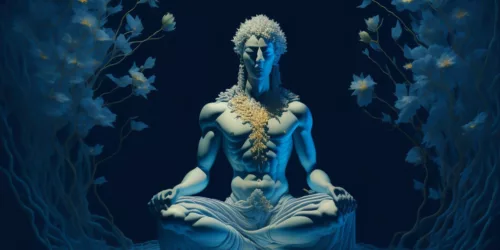The Role of Meditation in Ancient Egyptian Spirituality and Magic
Just as you're exploring the depths of meditation in your own life, it's fascinating to discover that ancient Egyptians were also deeply immersed in meditation practices as a cornerstone of their spirituality and magic.
They believed that through meditation, one could achieve a harmonious balance with Maat, the principle of cosmic order, and connect more intimately with the divine. These practices weren't just for the elite; they permeated society, offering insights into the mind and the universe.
As you ponder the significance of these ancient techniques, consider how they might illuminate paths to personal transformation and enlightenment in your own journey.
Key Takeaways
- Meditation was central to connecting with the divine and achieving enlightenment in Ancient Egyptian spirituality.
- Sacred spaces and rituals enhanced the power and efficacy of meditation practices.
- Principles of Maat were integrated into meditation to maintain cosmic balance and societal harmony.
- Modern practitioners can benefit from Kemetic meditation for mental well-being and spiritual connection.
Origins of Kemetic Meditation
Kemetic Meditation, deeply rooted in ancient Egypt's spiritual landscape, emerged as a cornerstone of religious practices, enabling priests and commoners alike to engage with divine realms and achieve inner harmony. This form of ancient Egyptian meditation wasn't just a method for relaxation; it was an integral aspect of spiritual practices that connected individuals to the deities and the universe. Priests, in their quest for wisdom, utilized meditation to communicate with gods and decipher the mysteries of existence. They employed visualization, a crucial element in Kemetic Meditation, to envision the gods, sacred symbols, and scenarios that facilitated divine encounters and revelations.
For the common people, meditation served as a bridge to the divine, offering a path to blessings, peace, and an enhanced state of consciousness. Through the practice of visualization, along with focused breath awareness, chanting, and ritualistic movements, individuals could transcend the physical realm and tap into the spiritual. This holistic approach not only fostered a connection with the divine but also promoted a balanced and harmonious life, in alignment with the cosmic order. Kemetic Meditation thus represents a profound embodiment of ancient Egyptian spiritual practices, emphasizing the transformative power of visualization in achieving spiritual enlightenment and harmony.
Understanding Maat's Principles
You'll find that Maat's core values are foundational to understanding the broader context of ancient Egyptian spirituality.
By examining Maat in everyday life, you'll uncover how these principles shaped not only personal ethics but also the societal norms of ancient Egypt.
This exploration will shed light on the intricate relationship between individual practices of meditation and the collective pursuit of harmony and balance.
Defining Maat's Core Values
Understanding Maat's principles unveils a multifaceted approach to living, where balance, order, truth, and justice aren't merely ideals but the very foundation upon which ancient Egyptian spirituality and ethical conduct were built. For the Ancient Egyptians, spiritual growth was intricately linked with living in harmony with Maat's core values. These values guided not only personal behavior but also ensured societal harmony and cosmic balance.
- Balance: Emphasizes the importance of equilibrium in all aspects of life.
- Truth: Advocates for honesty in interactions and self-reflection.
- Justice: Calls for fairness and the equitable treatment of others.
Adhering to these principles was seen as essential for achieving spiritual enlightenment and ensuring a favorable judgment in the afterlife.
Maat in Everyday Life
Exploring how Maat's principles were woven into the fabric of everyday life reveals their profound impact on ancient Egyptian society, guiding individuals in their pursuit of balance and harmony. Living in alignment with Maat meant upholding truth, justice, order, and cosmic balance—cornerstones of ethical conduct and spiritual practice. This adherence was not just about personal well-being but was essential for maintaining cosmic order, bringing blessings, prosperity, and spiritual enlightenment.
| Principle | Impact |
|---|---|
| Truth | Fostered a society built on honesty, enhancing a deeper connection among individuals. |
| Justice | Ensured fairness, cultivating trust and stability. |
| Order | Promoted structure, allowing for the flourishing of sacred symbols and rituals. |
| Cosmic Balance | Encouraged harmony with the universe, paving the way for spiritual enlightenment. |
Understanding and embodying these principles was fundamental, reflecting a profound engagement with the sacred in everyday life.
Key Deities and Symbols

In ancient Egyptian spirituality, key deities such as Osiris and symbols like the Ankh played pivotal roles in the culture's understanding of life, death, and the afterlife. These gods and goddesses, along with potent symbols, weren't just mythic figures or artistic representations; they were integral to the spiritual awakening and daily practices of the people. The Djed Pillar, symbolizing stability, was especially significant in rituals aimed at ensuring the balance and continuity of life.
- Osiris: As the god of the afterlife and resurrection, Osiris embodies the eternal cycle of life, death, and rebirth. His story encourages followers to seek spiritual transcendence.
- Ankh: This symbol, representing life, is often seen in the hands of gods and goddesses, signifying their ability to grant life and offer protection against the unknown forces of the afterlife.
- Djed Pillar: Symbolizing stability, it represents the backbone of Osiris. It serves as a reminder of the strength and resilience required for spiritual awakening and maintaining cosmic order.
These elements of ancient Egyptian spirituality underscore a complex understanding of the universe, where life and the afterlife are deeply interconnected, guided by divine forces and symbolized through powerful icons.
Sacred Space Preparation
As you explore the nuanced practices of sacred space preparation in ancient Egyptian spirituality, you'll find that identifying specific locations deemed sacred was a foundational step.
This was closely followed by meticulous ritual cleansing methods, ensuring the space was purified from any profane energies.
Lastly, invoking protective deities through the strategic placement of symbols and offerings was crucial for safeguarding the sanctity of the space and enhancing the practitioner's connection to divine energies.
Identifying Sacred Locations
Selecting sacred locations in ancient Egypt wasn't merely about picking a spot; it required a deep understanding of energetic qualities and celestial alignments to ensure spiritual efficacy. This meticulous selection process was integral for the practice of meditation techniques, fostering a profound connection with divine energies. The chosen sacred spaces—whether temples, tombs, or natural landscapes—had to resonate with the spiritual purpose of the rituals and meditations conducted within them.
- Energetic Qualities: The vibration of a place contributed to its sacredness, enhancing meditative and ritualistic practices.
- Celestial Alignments: Alignment with celestial bodies was believed to open channels to divine energies.
- Spiritual Resonance: A space needed to spiritually resonate with both the practitioners and the intended divine entities to maximize the potency of their connection.
Ritual Cleansing Methods
Understanding the energetic qualities and celestial alignments crucial for selecting sacred locations, it's essential to consider the ritual cleansing methods that prepared these spaces for spiritual practices. Ancient Egyptian priests and practitioners meticulously employed purification techniques involving water, natron, oils, and incense. These substances weren't merely physical cleansers; they symbolized a deeper purification of the body and mind, aligning the sacred space with cosmic energies.
| Element | Purpose | Symbolism |
|---|---|---|
| Water | Physical cleansing | Purity, Life |
| Natron | Purification | Renewal, Balance |
| Incense | Atmosphere preparation | Connection to the Divine |
Such sacred space preparation, including offerings to deities, was paramount for invoking their presence and ensuring the efficacy of magical ceremonies. This thoughtful preparation fostered a harmonious environment, pivotal for successful spiritual work.
Invoking Protective Deities
In the preparation of sacred spaces for Ancient Egyptian meditation, practitioners actively invoked protective deities such as Sekhmet and Anubis, employing offerings and symbols to create a spiritually fortified environment. Through the use of incense, sacred oils, and potent symbols like the Eye of Horus and the Ankh, these spaces became conduits for divine protection and spiritual depth. Chanting rituals and invocations were critical in calling upon the energies of these deities, ensuring the practitioner's safety and enhancing their connection to the spiritual realm.
- Offerings and Symbols: Tools for aligning the sacred space with divine energies, reinforcing the barrier against negative influences.
- Chanting Rituals: A vibrational bridge between the practitioner and the divine, facilitating a deeper spiritual communion.
- Protective Deities: Guardians of the spiritual journey, their invoked presence providing safety and guidance.
Step-by-Step Meditation Guide
To embark on the journey of ancient Egyptian meditation, you'll first need to master the art of breathwork, which serves as the foundation for connecting with the Ka. This life force energy is pivotal in ancient Egyptian spirituality, and breathwork enables you to tune into its vibrancy. As you inhale and exhale deeply, envision the breath moving through your body, revitalizing every cell and aligning you with the universe's rhythm.
Next, incorporate the visualization of sacred geometry and ancient symbols into your practice. The Egyptians revered the power of symbols like the Ankh and the Eye of Horus, which represented eternal life and protection. Visualizing these symbols during meditation can deepen your connection to the divine and enhance your spiritual awareness. Furthermore, the use of sacred geometry, particularly the pyramid shape, can facilitate a profound transformation. Its structure symbolizes the ascension to higher consciousness, guiding your spirit through the levels of enlightenment.
As you chant mantras, focus on the resonance of the sacred sounds. These vocalizations aren't mere words but vibrations that align with the cosmos's energy. They serve as a bridge between the physical and spiritual realms, enabling you to transcend earthly limitations and achieve unity with the Divine. Through diligent practice, this step-by-step guide empowers you to harness the transformative power of ancient Egyptian meditation.
Daily Integration Practices

Having explored the foundational techniques of ancient Egyptian meditation, let's now examine how these practices were seamlessly woven into daily life, highlighting their significance in achieving spiritual enlightenment and divine connection. Incorporating meditation into daily routines wasn't merely a spiritual endeavor; it was a necessary discipline for maintaining harmony and balance within the self and the surrounding world.
This integration was achieved through:
- Rituals that involved precise movements and chants, creating a rhythm that aligned practitioners with the cosmic order.
- Visualization techniques that brought practitioners closer to the deities, enabling a profound connection and communication with divine energies.
- The creation and maintenance of a sacred space, often adorned with sacred symbols and infused with specific aromas, which served as a tangible bridge between the earthly and the divine.
These daily practices underscored the ancient Egyptians' belief in the power of meditation to access hidden realms, deepen consciousness, and seek guidance from deities. By invoking the elements of nature and maintaining a dedicated sacred space, they ensured that their connection to the divine wasn't just reserved for the temples but was a living, breathing part of their everyday existence.
Modern Relevance and Benefits
As modern research confirms, the ancient Egyptian practice of Kemetic meditation offers significant mental health benefits, enhancing mental clarity and emotional well-being for contemporary individuals. This ancient technique, deeply rooted in the spiritual landscape of Egypt, leverages sacred symbols and deities to foster a connection that goes beyond the physical, touching the essence of one's spiritual being. The integration of these spiritual elements into daily routines can significantly amplify the overall health and resilience of individuals, promoting a balanced life amidst modern-day challenges.
Delving into Kemetic meditation facilitates a deeper understanding of oneself and the universe. It's a pathway to sustainable spirituality, accommodating the diverse needs of today's fast-paced world. By embracing these inclusive practices, you're not just participating in a ritual; you're engaging with a wisdom that has withstood the test of time, offering solutions and solace to contemporary seekers.
Platforms like Insight Timer, which boasts over 18 million users globally, provide accessible gateways to these ancient practices. Through free guided meditations, individuals can explore the profound benefits of Kemetic meditation, connecting with a community that values spiritual growth and enlightenment. This ancient practice, therefore, remains not only relevant but essential in our pursuit of mental and spiritual well-being today.
Expanding Your Meditation Journey

Building upon the foundation of Kemetic meditation's modern relevance, you can further enrich your spiritual practice by exploring advanced techniques from ancient Egyptian texts. Delving into these practices offers a pathway to deeper states of consciousness, connecting you with the profound spiritual wisdom of the ancients.
To elevate your meditation journey, consider integrating the following elements into your practice:
- Sacred Sounds and Mantras: Utilize the vibrational power of sacred sounds and mantras found in ancient texts. These are believed to resonate with the energy of the universe, facilitating a deeper connection to the divine.
- Visualization Techniques: Harness the power of visualization to transport your consciousness to sacred spaces, such as the interiors of pyramids. This method draws on the symbolism of these structures as gateways to enlightenment.
- Engagement with Symbolism: Immerse yourself in the rich symbolism of Egyptian spirituality. Understanding the symbolic representations found in texts and artifacts can unlock layers of meaning, deepening your meditation experience.
Frequently Asked Questions
What Was the Role of Magic in Ancient Egypt?
In ancient Egypt, magic practices were pivotal, intertwining daily life and spirituality. You'd find protective amulets, deity invocation, and rituals aimed at harnessing cosmic order, reflecting a profound belief in magic's power to shape reality.
Did Ancient Egyptians Meditate?
Yes, you'll find that ancient Egyptians practiced meditation, integrating techniques with spiritual symbols for deeper insights. Their healing practices often relied on meditation's power, reflecting a sophisticated understanding of its benefits for mind and body.
How Did Ancient Egyptians Practice Spirituality?
You're navigating a river of spirituality, where ancient Egyptians honored gods through worship, embraced afterlife beliefs, and engaged in temple rituals to connect deeply with the divine, weaving a rich tapestry of spiritual practice.
What Is Egyptian Position Meditation?
Egyptian Position Meditation integrates body postures, healing techniques, and symbolic gestures, enabling you to embody deity archetypes. Through yoga-like poses, you'll access transformative energies for spiritual growth, without delving into its historical spiritual role.
Conclusion
In your exploration of ancient Egyptian spirituality and magic, you've begun to unlock the transformative power of Kemetic meditation. Yet, this journey is merely the threshold.
Beyond lies a realm teeming with profound insights and boundless possibilities, awaiting your discovery. Embracing Maat's principles and delving deeper into sacred practices promises not only personal enlightenment but a profound connection to the universe's very essence.
Dare to expand your meditation journey, for what you uncover next could redefine your understanding of reality itself.






